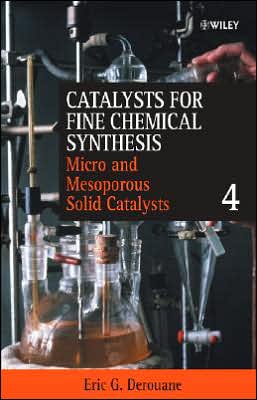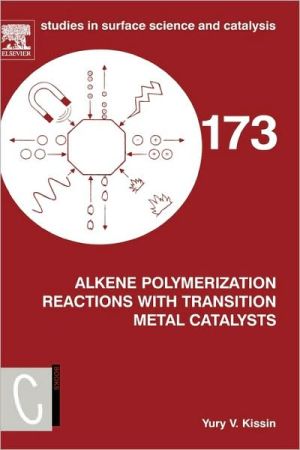Catalysts For Fine Chemical Sy, Vol. 4
This series offers practical help for advanced undergraduate, graduate and postgraduate students, as well as experienced chemists in industry and academia working with catalysts in organic and organometallic synthesis. It features tested and validated procedures, authoritative reviews on classes of catalysts, and assessments of all types of catalysts. Micro- and Mesoporous Solid Catalysts describes the use of zeolites and mesoporous solids as catalysts for the production of fine and specialty...
Search in google:
Catalysts are increasingly used by chemists engaged in fine chemical synthesis within both industry and academia. Today, there is a huge choice of high-tech catalysts that adds enormously to the repertoire of synthetic possibilities. However, catalysts are occasionally capricious, sometimes difficult to use and almost always require both skill and experience in order to achieve optimal results. This series offers practical help for advanced undergraduate, graduate and postgraduate students, as well as experienced chemists in industry and academia working with catalysts in organic and organometallic synthesis. It features tested and validated procedures, authoritative reviews on classes of catalysts, and assessments of all types of catalysts. Micro- and Mesoporous Solid Catalysts describes the use of zeolites and mesoporous solids as catalysts for the production of fine and specialty chemicals. Specific tips and hints are provided and some typical procedures are described in detail. In addition to discussing the pros and cons of various micro- and mesoporous solids used as catalysts, several major organic transformations are examined including aromatic substitutions, heterocyclic ring formation, amines synthesis, oligomerisation, oxidation and hydroxylation, and other regioselective and stereoselective reactions. Micro- and Mesoporous Solid Catalysts features tutorial introductory chapters, including tips and hints for achieving successful organic transformations. Important reactions are featured together with recommendations to resolve potential problems. This book is an important text for undergraduate and graduate students, andprofessionals working as practising zeolite and synthetic organic chemists in industry and academia.
Series Preface ixPreface to Volume 4 xiAbbreviations xiiiAn Overview of Zeolite, Zeotype and Mesoporous Solids Chemistry: Design, Synthesis and Catalytic Properties Thomas Maschmeyer Leon van de Water 1Zeolites, zeotypes and mesoporous solids: synthetic aspects 1Introduction 1Synthetic aspects: template theory for zeolite synthesis 2Synthetic aspects: template theory for mesoporous oxides synthesis 7Design of extra-large pore zeolites and other micro- and mesoporous catalysts 11Introduction 11Extra-large pore zeolites 11Hierarchical pore architectures: combining micro- and mesoporosity 13Potential of post-synthesis functionalized micro- and mesoporous solids as catalysts for fine chemical synthesis 19Introduction 19Covalent functionalization 20Noncovalent immobilization approaches 25Single-site catalysts inspired by natural systems 29References 30Problems and Pitfalls in the Applications of Zeolites and other Microporous and Mesoporous Solids to Catalytic Fine Chemical Synthesis Michel Guisnet Matteo Guidotti 39Introduction 39Zeolite catalysed organic reactions 42Fundamental and practical differences with homogeneous reactions 42Batch mode catalysis 45Continuous flow mode catalysis 51Competition for adsorption: influence on reaction rate, stability and selectivity 53Catalyst deactivation 61General conclusions 63References 64Aromatic Acetylation Michel Guisnet Matteo Guidotti 69Aromatic acetylation 69Acetylation with Acetic Anhydride 70Acetylation with Acetic Acid 82Procedures and protocols 89Selective synthesis of acetophenones in batch reactors through acetylation with acetic anhydride 89Selective synthesis of acetophenones in fixed bed reactors through acetylation with acetic anhydride 90References 91Aromatic Benzoylation Patrick Geneste Annie Finiels 95Aromatic benzoylation 95Effect of the zeolite 96Effect of the acylating agent 97Effect of the solvent 97Benzoylation of phenol and the Fries rearrangement 97Kinetic law 99Substituent effect 100Experimental 101Acylation of anisole over mesoporous aluminosilicates 102References 103Nitration of Aromatic Compounds Avelino Corma Sara Iborra 105Introduction 105Reaction mechanism 106Nitration of aromatic compounds using zeolites as catalysts 107Nitration in liquid phase 107Vapour phase nitration 116Conclusions 118References 118Oligomerization of Alkenes Avelino Corma Sara Iborra 125Introduction 125Reaction mechanisms 126Acid zeolites as catalysts for oligomerization of alkenes 127Medium pore zeolites: influence of crystal size and acid site density 127Use of large pore zeolites 130Catalytic membranes for olefin oligomerization 131Mesoporous alominosilicates as oligomerization catalysts 131Nickel supported aluminosilicates as catalysts 132References 136Microporous and Mesoporous Catalysts for the Transformation of Carbohydrates Claude Moreau 141Introduction 141Hydrolysis of sucrose in the presence of H-form zeolites 142Hydrolysis of fructose and glucose precursors 143Isomerization of glucose into fructose 144Dehydration of fructose and fructose-precursors 145Dehydration of xylose 146Synthesis of alkyl-D-glucosides 147Synthesis of butyl-D-glucosides 147Synthesis of long-chain alkyl-D-glucosides 150Synthesis of alkyl-D-fructosides 151Hydrogenation of glucose 151Oxidation of glucose 153Conclusions 154References 154One-pot Reactions on Bifunctional Catalysts Michel Guisnet Matteo Guidotti 157Introduction 157Examples 158One-pot transformations involving successive hydrogenation and acid-base steps 158One-pot transformations involving successive oxidation and acid-base steps 166References 168Base-type Catalysts Didier Tichit Sara Iborra Avelino Corma Daniel Brunel 171Introduction 171Characterization of solid bases 172Test reactions 172Probe molecules combined with spectroscopic methods 174Solid base catalysts 175Alkaline earth metal oxides 175Catalysis on alkaline earth metal oxides 177Hydrotalcites and related compounds 183Organic base-supported catalysts 187Conclusions 195References 195Hybrid Oxidation Catalysts from Immobilized Complexes on Inorganic Microporous Supports Dirk De Vos Ive Hermans Ben Sels Pierre Jacobs 207Introduction and scope 207Oxygenation potential of heme-type complexes in zeolite 211Metallo-phthallocyanines encapsulated in the cages of faujasite-type zeolites 211Oxygenation potential of metallo-phthallocyanines encapsulated in the mesopores of VPI-5 AIPO[subscript 4] 215Oxygenation potential of zeolite encapsulated metallo-porphyrins 216Oxygenation potential of zeolite encapsulated nonheme complexes 220Immobilization of N,N[prime]-bidentate complexes in zeolite Y 220Ligation of zeolite exchanged transition ions with bidentate aza ligands 224Ligation of zeolite exchanged transition ions with tri- and tetra-aza(cyclo)alkane ligands 225Ligation of zeolite exchanged transition ions with Schiff base-type ligands 228Zeolite effects with N,N[prime]-bis(2-pyridinecarboxamide) complexes of Mn and Fe in zeolite Y 231Zeolite encapsulated chiral oxidation catalysts 233Conclusions 235Acknowledgements 235References 235Subject Index 241








